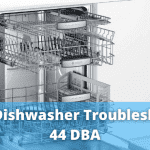Table of Contents
Bosch dishwasher error code e09 is a standard Bosch dishwasher error that can be resolved by following these troubleshooting tips. A Bosch dishwasher error code e09 error occurs when the control board detects an issue with one of the electrical components, such as the water inlet valve or heating element.
We will discuss how to fix the Bosch dishwasher error code e09 so you can continue to enjoy your new appliance!
What is the purpose of this error? What does it imply?
One of the more frustrating errors you may encounter with your dishwasher is an E09 code.
This typically occurs when there’s a breakage in one of its heating elements and tells us to call someone who can fix this for us quickly before it damages other parts as well!
Please note! The E09 error code is exclusively used in devices from the third generation. As a result, knowing the make and model of your device is essential if you want to replace a compatible replacement part.
In rare cases, failures in the temperature sensor or control card can cause this error and a fault with the wiring between the heating element and module.
Heater Burnt
The heater has burnt because of the following reasons:
- There is water in the heater. Leakage points may have developed, allowing it to enter the heater. The most typical reason for this location isis a rubber band sandwiched between the dishwasher body and filter glass.
- The drainage filter is clogged. Water enters the tank slowly because of blockages, and the heating element overheats as a result. It causes significant wear.
- Scale and minerals. If the ion exchanger is not sufficiently salty, the water becomes hard. The scale forms when the water is heated. The bloom causes extended heating time and heater failure as time goes on.
Replacement of the heater
Replacing the heating element of a Bosch dishwasher is not difficult. We’ll need a crosshead screwdriver, a multimeter, and a new heating element for this.
The main problem is that the heater is connected to the circulation unit, so we must disconnect it to remove the heating element.
It means that you must disassemble the dishwasher almost entirely if this does not deter you from working. START WORKING IF THIS DOES NOT STOP YOU!
- At this stage, the Bosch dishwasher is linked to the sewage system, water supply, and electricity, so first, disconnect it from the indicated units.
- Remove the adhesive on the sides of the body and then remove the plastic clips on the surface. Remove the front portion of the device by unscrewing it.
- Remove the thin, narrow metal panel, which is located below the dishwasher door.
- Remove the heat-insulating wrap and set it aside.
- The screws that secure the pallet should be loosened.
- Take out the dishwasher’s baskets for plates.
- Remove the garbage filter glass from the lower sprinkler. Also, take out the metal mesh that sits on the bottom of the cleaning body.
- Unscrew the four screws that secure the circulation unit to the body from the side.
- On the back wall, place a well-absorbent cloth on the floor behind the dishwasher, then install “home assistant.
- Remove the pallet from the circulation unit. Disconnect the filling nozzle from the circulation unit and remove it.
Note: Do not pull the pallet too far toward yourself; just enough to let more accessible access to the components attached to it is sufficient.
- Turn the drain pump counterclockwise, remove it, and set it aside.
- Remove the circulation device from the connections that are attached with care.
- Remove the drain hose and pull out the appliance, disconnecting any chips with wires.
- Remove the heating element’s clamp and disconnect it from the circulation unit, taking out the chips with the wires. To avoid confusion when reassembling, take a photo of their position before removing the fragments.
- Unpack the new heater and replace the old one, connecting all of the chips to the contacts.
Perhaps the heating element itself is not at fault. As a result, before replacing it, use a multimeter to check the existing component’s resistance.
Finally, reverse the order in which you installed the dishwasher and test its function. The repair is now completed!
Recent Posts:
How To Fix Samsung Dishwasher Error Codes? (SOLVED)
Whirlpool Dishwasher Not Washing: Here’s Why

















